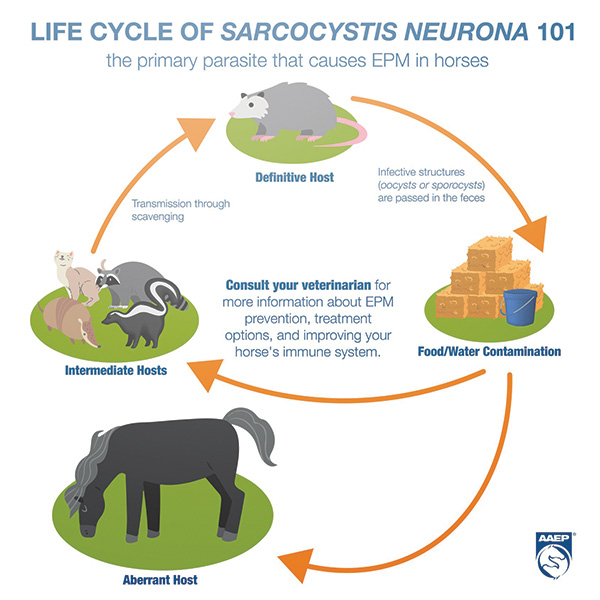Equine Protozoal Myeloencephalitis (EPM) is a disease that every horse owner should be aware of. It’s a neurological condition that can have devastating effects on the health and well-being of horses if not diagnosed and treated promptly. In this first part of our four-part series on EPM, we will explore what this disease is, how it affects horses, and why it poses such a significant threat.
What is Equine Protozoal Myeloencephalitis (EPM)? EPM is a serious neurological disorder in horses caused by the protozoan parasite Sarcocystis neurona. This parasite attacks the central nervous system of equines, leading to a range of symptoms that can vary in severity. Jennifer Rush, DVM, of Tennessee Equine Hospital states, “EPM is a neurologic disease of horses caused by a protozoal infection of the central nervous system involving the organisms Sarcocystis neurona and Neospora hughesi. While the information on the lifecycle of N. Hughesi is incredibly limited, the 2-host lifecycle of S. Neurona is broadly understood to jump between the opossum gastro-intestinal tract and the muscle tissue of multiple intermediate hosts. Instead of encysting within the muscle tissue, the parasites abnormally migrate to the central nervous system.”
How Do Horses Contract EPM? Horses contract EPM through exposure to the infective stage of the parasite, which is found in the feces of infected opossums. According to Kyla Szemplinski, MS, at UT TSU Shelby County Extension, horses are infected by “consuming forage, feed or water that is contaminated with the infective protozoa feces.”
When horses consume contaminated feed or water, they ingest the sporocysts, which then invade the bloodstream and reach the central nervous system. This process of transmission makes EPM a concern for horse owners, especially those in areas with a high opossum population. According to Kyla, “there is a possibility for long term effects/relapses and some horses do not even survive.” While Dr. Jennifer notes, “infected horses are considered dead-end hosts and are not a biosecurity risk to infect other horses,” which can be good news if a single horse in a herd is diagnosed with EPM. It does not mean others will also show signs, symptoms, or become infected with EPM.

Which Horses are Most Susceptible to Contracting EPM? While any horse can potentially contract EPM, certain factors increase susceptibility. Horses under stress, such as those undergoing intense training, transportation, or experiencing changes in feed or environment, are more vulnerable. Young horses, senior horses and those with weakened immune systems are also at higher risk. Additionally, horses living in areas with a high prevalence of opossums are more likely to be exposed to the parasite.
How Long Does it Take for Horses to Show Symptoms? The time it takes for symptoms of EPM to appear can vary greatly. Some horses show signs within a couple of weeks of exposure, while others may not display symptoms for months or even years. This variability can make early detection challenging. Veterinarians emphasize that early intervention is critical in managing EPM, so horse owners should be vigilant in monitoring their animals for any changes in behavior or gait.
How Does EPM Attack the Horse Overall? Once the parasite reaches the central nervous system, it begins to cause inflammation and damage to neural tissues. This can lead to a wide range of neurological symptoms, from mild coordination issues like tripping, to severe paralysis and incoordination such as falling down unexpectedly. The exact symptoms depend on the location and extent of the damage within the nervous system. This unpredictability makes EPM a particularly complicated disease to diagnose and treat.
Why is EPM a Severe Disease in Horses? EPM is severe because it directly impacts the nervous system, affecting a horse’s ability to move and function normally. If left untreated, the disease can progress rapidly, leading to irreversible damage and, in some cases, death. The severity of EPM also lies in its ability to mimic other neurological disorders, complicating diagnosis and treatment efforts.
Why is EPM a Complicated Disease in Horses? EPM is complicated due to its complex lifecycle, varied symptoms, and the challenges associated with diagnosis. Differentiating EPM from other neurological disorders requires a thorough evaluation and often multiple diagnostic tests. Treatment can be lengthy and costly, with no guarantee of complete recovery. According to the University of Minnesota Extension, “About 60 to 70 percent of horses treated for EPM will improve, but it is estimated that only 15 to 25 percent will recover completely.” Szemplinski notes that “EPM is a challenging disease but prevention can be key to protecting your horses.”
Understanding EPM and its impact on horses is the first step in safeguarding your equine companions. In the next part of our series, we will discuss the first signs and symptoms of EPM, ranging from the very mild to more advanced stages. Please stay updated to learn how to recognize the early indicators of this serious disease and how to take action quickly.










